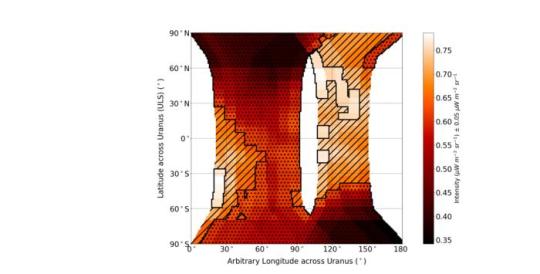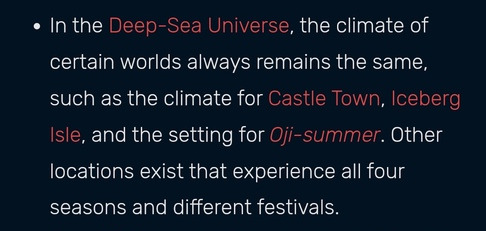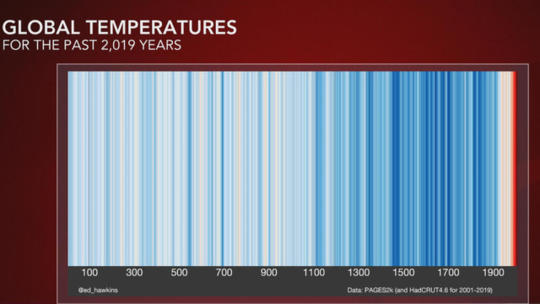#TEMPERATURE-DEPENDENT PHENOMENA
Text
NASA sees Tropical Cyclone Nora become a hurricane



IMAGE: On March 23 at 12: 36 a.m. EDT (0436 UTC) a noticeable picture of Hurricane Nora was obtained from the VIIRS instrument aboard NASA-NOAA’s Suomi NPP satellite as it continued …
view more
Credit: Credits: NOAA/NASA Quick Action Group
NASA satellite images revealed that Hurricane Nora established an eye as it enhanced into a typhoon north of Australia. NASA-NOAA’s Suomi NPP satellite supplied forecasters with a noticeable picture of the storm, previously called Hurricane 16 P.
The Australian Bureau of Meteorology or ABM released cautions and expect Nora. A Caution Zone is in impact from the mouth of the Gilbert River to Thursday Island, consisting of Weipa. The Watch Zone extends from the Northern Territory/Queensland border to the mouth of the Gilbert River.
On March 23 at 12: 36 a.m. EDT (0436 UTC) the Noticeable Infrared Imaging Radiometer Suite (VIIRS) instrument aboard NASA-NOAA’s Suomi NPP satellite caught a noticeable picture of Hurricane Nora as it continued moving in between northern Australia and New Guinea. The image was developed at NASA’s Goddard Space Flight Center in Greenbelt, Maryland and revealed an eye surrounded by effective thunderstorms covering into the low-level center of flow.
At 5 a.m. EST (0900 UTC) on March 23, the center of Hurricane Nora was 438 nautical miles east-northeast of Darwin, Australia near 11.0 degrees south latitude and 138.5 degrees east longitude. Nora was approaching the southeast near 15 miles per hour (13 knots/24 kph). Optimum sustained winds were near 75 miles per hour (65 knots/120 kph) making Nora a Classification 1 cyclone on the Saffir-Simpson cyclone wind scale.
Nora is anticipated to continue reinforcing and moving southeast into the Gulf Carpentaria.
ABM kept in mind on March 23 “Serious Hurricane Nora continues to magnify as a Classification 3 strength cyclone as it moves southeasterly throughout the northern Gulf of Carpentaria. The Hurricane is anticipated to reach Classification 4 strength throughout Saturday while over the northeast Gulf of Carpentaria. On Sunday, the Hurricane is anticipated to take a more southerly track and move to the southeastern Gulf of Carpentaria coast, although a seaside crossing anywhere along the western Cape York Peninsula south of Mapoon throughout Saturday afternoon or Sunday is likewise possible. By Monday, the Hurricane is anticipated to end up being sluggish moving over the southeastern Gulf of Carpentaria or inland of the coast.”
The Joint Tropical cyclone Caution Center’s prolonged projection requires Nora to approach Mornington Island on March 26 and make landfall in southwestern Queensland on March 27.
For projection updates, go to ABM: http://www.bom.gov.au
###
Disclaimer: We can make errors too. Have a great day.
New post published on: https://livescience.tech/2018/03/24/nasa-sees-tropical-cyclone-nora-become-a-hurricane/
#ATMOSPHERIC CHEMISTRY#ATMOSPHERIC SCIENCE#CLIMATE SCIENCE#EARTH SCIENCE#METEOROLOGY#OCEANOGRAPHY#TECHNOLOGY/ENGINEERING/COMPUTER SCIENCE#TEMPERATURE-DEPENDENT PHENOMENA#WEATHER/STORMS
0 notes
Text
Headcanons about the Devildom
I've been thinking about Devildom as a place, as an ecosystem and its relation with its habitantes, so here go some things.
Devildom is huge and has extreme weather. There are icy areas and others that exceed 100 ºC.
However, only few places can be inhabited by all types of demons. Being the largest the capital, where is the RAD.
Most of the population lives in the capital.
In the few peripheral municipalities (with more extreme temperatures) the devils are very well adapted.
There are very severe annual cold waves. The demons prepare for them as we can prepare for snowfall.
I think that demons tolerate heat better than cold, especially cold-blooded ones like Levi, so during these times their activity decreases, like animals that hibernate. Lucifer hate this time because he is not efficient as always.
An exception to this would be ice demons or those that are highly adapted to cold.
There are also waves of magic of different natures that trigger certain events or herald times of strength for demons using certain types of magic or collective debuffing.
For example, if a magic wave comes at the beginning of the year from the north, it is known that it will be a year in which certain magic mushrooms will not grow. Or something like that.
Our dear demons are affected by these phenomena, they can be seen more restless or totally tired, depending on the time. Angels are affected in a similar way.
In Solomon's case, as he has been involved in magical shenanigans for centuries, he has become more or less sensitive to these phenomena.
And then there is Mc, who is like a cockroach, they are easy to kill but can survive almost all kinds of environmental changes (removing those that are very extreme) So they are in charge of pampering the brothers when they are indisposed by the "weather".
.
.
.
I think it's very fun to think about these things, in general I love to think about the daily life of the characters. So if anyone has similar headcanons I'd love to read them.
If you have come this far, thank you very much. It's probably full of bugs, but I'll try to correct it little by little.
#obey me#obey me! shall we date?#obey me shall we date#omswd#obey me game#obey me headcanons#obey me devildom#obey me imagines#obey me lore#obey me demons#obey me angels#obey me humans#obey me brothers#headcannons
544 notes
·
View notes
Text
I'd like to put "the wikipedia page for 'seasons'" on the list of Required Reading For Worldbuilders, and here's why.
seasons can be literally physically different in various parts of our own world; whatever system you're most familiar with (and if you're from an anglophone temperate region it's prolly spring-summer-autumn-winter), it's not universal
even when looking at the same phenomena, there's different ways of categorizing it; like you can divide it into four seasons, or six seasons, depending on what you consider significant enough changes
even when looking at the same way of categorizing seasons, there's different ways of CALCULATING them; do you look at temperature, astronomical placement, weather conditions, the calendar (which just bumps to question to "who set it on the calendar and what criteria were they using"), particular activity of plants or animals…
sure there's some technical terms that made my eyes glaze over, but it's a vitally important research skill, if you have no intention of delving deep into a particular field, to learn how to read PAST the stuff you don't know; to either look them up and continue with greater knowledge, or skip over them and not get bogged down in what you don't understand
17 notes
·
View notes
Text




Uranus aurora discovery offers clues to habitable icy worlds
The presence of an infrared aurora on the cold, outer planet of Uranus has been confirmed for the first time by University of Leicester astronomers.
The discovery could shed light on the mysteries behind the magnetic fields of the planets of our solar system, and even on whether distant worlds might support life.
The team of scientists, supported by the Science and Technology Facilities Council (STFC), have obtained the first measurements of the infrared (IR) aurora at Uranus since investigations began in 1992. While the ultraviolet (UV) aurorae of Uranus has been observed since 1986, no confirmation of the IR aurora had been observed until now. The scientists’ conclusions have been published in the journal Nature Astronomy.
The ice giants Uranus and Neptune are unusual planets in our solar system as their magnetic fields are misaligned with the axes in which they spin. While scientists have yet to find an explanation for this, clues may lie in Uranus’s aurora.
Aurorae are caused by highly energetic charged particles, which are funnelled down and collide with a planet's atmosphere via the planet's magnetic field lines. On Earth, the most famous result of this process are the spectacles of the Northern and Southern Lights. At planets such as Uranus, where the atmosphere is predominately a mix of hydrogen and helium, this aurora will emit light outside of the visible spectrum and in wavelengths such as the infrared (IR).
The team used infrared auroral measurements taken by analysing specific wavelengths of light emitted from the planet, using the Keck II telescope. From this, they can analyse the light (known as emission lines) from these planets, similar to a barcode. In the infrared spectrum, the lines emitted by a charged particle known as H3+ will vary in brightness depending on how hot or cold the particle is and how dense this layer of the atmosphere is. Hence, the lines act like a thermometer into the planet.
Their observations revealed distinct increases in H3+ density in Uranus’s atmosphere with little change in temperature, consistent with ionisation caused by the presence of an infrared aurora. Not only does this help us better understand the magnetic fields of the outer planets of our own solar system, but it may also help in identifying other planets that are suitable of supporting life.
Lead author Emma Thomas, a PhD student in the University of Leicester School of Physics and Astronomy, said: “The temperature of all the gas giant planets, including Uranus, are hundreds of degrees Kelvin/Celsius above what models predict if only warmed by the sun, leaving us with the big question of how these planets are so much hotter than expected? One theory suggests the energetic aurora is the cause of this, which generates and pushes heat from the aurora down towards the magnetic equator.
“A majority of exoplanets discovered so far fall in the sub-Neptune category, and hence are physically similar to Neptune and Uranus in size. This may also mean similar magnetic and atmospheric characteristics too. By analysing Uranus's aurora which directly connects to both the planet's magnetic field and atmosphere, we can make predictions about the atmospheres and magnetic fields of these worlds and hence their suitability for life.
"This paper is the culmination of 30 years of auroral study at Uranus, which has finally revealed the infrared aurora and begun a new age of aurora investigations at the planet. Our results will go on to broaden our knowledge of ice giant auroras and strengthen our understanding of planetary magnetic fields in our solar system, at exoplanets and even our own planet."
The results may also give scientists an insight into a rare phenomenon on Earth, in which the north and south pole switch hemisphere locations known as geomagnetic reversal.
Emma adds: “We don't have many studies on this phenomena and hence do not know what effects this will have on systems that rely on Earth's magnetic field such as satellites, communications and navigation. However, this process occurs every day at Uranus due to the unique misalignment of the rotational and magnetic axes. Continued study of Uranus's aurora will provide data on what we can expect when Earth exhibits a future pole reversal and what that will mean for its magnetic field.”
TOP IMAGE....An artistic representation of how the northern infrared aurora would have looked like in 2006 (marked in red). The darker red locations indicate confirmed aurora locations, with fainter red used to mark possible aurora locations. Credit to NASA, ESA and M. Showalter (SETI Institute) for the background image of Uranus, as was observed by the Hubble Space Telescope (in the visible spectrum) in August 2005. CREDIT Credit to NASA, ESA and M. Showalter (SETI Institute) for the background image of Uranus, as was observed by the Hubble Space Telescope (in the visible spectrum) in August 2005.
CENTRE IMAGE....Averaged emission spectrum between 3.4 and 4.0μm, with annotated positions of valuable H3+ emission lines (known as Q lines) found at specific wavelength locations, the brightness of each line is determined by both temperature and density of the H3+ particles in a planet's atmosphere CREDIT Source: University of Leicester
LOWER IMAGE....Measured infrared brightness from the upper atmosphere of Uranus combined with rings of magnetic field lines which occur as the planet rotations (which produces the oval shape we see in most aurora). These rings are called shells and we expect the majority of auroral signal to occur between the dashed and dotted lines (as seen in 1986), which a portion of our results do. CREDIT Source: University of Leicester
BOTTOM IMAGE....Measured infrared brightness from the upper atmosphere of Uranus over a 6-hour period, areas highlighted with a black border and no hash or dots are locations of enhanced emission (aurora). Hashed areas means possible aurora though the signal is too weak to confirm and dotted areas means no aurora in these points. CREDIT Source: University of Leicester
42 notes
·
View notes
Text
Our physical and psychical views spring in exactly the same manner from instinctive knowledge. We read the thoughts of men in their acts and facial expressions without knowing how. Just as we predict the behavior of a magnetic needle placed near a current by imagining Ampère's swimmer in the current, similarly we predict in thought the acts and behavior of men by assuming sensations, feelings, and wills similar to our own connected with their bodies. What we here instinctively perform would appear to us as one of the subtlest achievements of science, far outstripping in significance and ingenuity Ampère's rule of the swimmer, were it not that every child unconsciously accomplished it. The question simply is, therefore, to grasp scientifically, that is, by conceptional thought, what we are already familiar with from other sources. And here much is to be accomplished. A long sequence of facts is to be disclosed between the physics of expression and movement and feeling and thought.
We hear the question, "But how is it possible to explain feeling by the motions of the atoms of the brain?" Certainly this will never be done, no more than light or heat will ever be deduced from the law of refraction. We need not deplore, therefore, the lack of ingenious solutions of this question. The problem is not a problem. ...
Let us look at the matter without bias. The world consists of colors, sounds, temperatures, pressures, spaces, times, and so forth, which now we shall not call sensations, nor phenomena, because in either term an arbitrary, one-sided theory is embodied, but simply elements. The fixing of the flux of these elements, whether mediately or immediately, is the real object of physical research. As long as, neglecting our own body, we employ ourselves with the interdependence of those groups of elements which, including men and animals, make up foreign bodies, we are physicists. For example, we investigate the change of the red color of a body as produced by a change of illumination. But the moment we consider the special influence on the red of the elements constituting our body, outlined by the well-known perspective with head invisible, we are at work in the domain of physiological psychology. We close our eyes, and the red together with the whole visible world disappears. There exists, thus, in the perspective field of every sense a portion which exercises on all the rest a different and more powerful influence than the rest upon one another. With this, however, all is said. In the light of this remark, we call all elements, in so far as we regard them as dependent on this special part (our body), sensations. That the world is our sensation, in this sense, cannot be questioned. ...
Ernst Mach, "On the Economical Nature of Physical Inquiry"
16 notes
·
View notes
Text
Day 15; lore from my main story!
[Pulled from a classified document found on the desk of Commander and Head Supervisor of Unusual Occurrences Ground Operations Henry Blanche]
Due to the failure in our most recent technological advancements, our world, and presumably the one we’ve tried to contact, is beginning to experience strange unnatural phenomena. For simplicity’s sake, it has been dubbed Reality Dragging. The process seems to have occurred as our two realities became linked, then unlinked, within the same second. Since this experiment, these links have been spontaneously opening for short periods of time all over the globe. Anything that can fit through the brief tear created when our worlds are linked can be dragged into the opposite reality. It doesn’t matter where the thing is when it is Dragged, but the spot where it is Dragged from will produce a strange energy. It is still unknown whether said energy can be harnessed by anything other than a being that was Dragged, or if we can safely travel through and return from these spots. As of now, we know that whatever is Dragged into a new reality has no way to return to its place of origin. It does exhibit a few strange traits if it’s a sentient and functioning creature, however.
The following information has been found through a trial and error process that involves numerous Dragged specimens’ deaths:
Further abilities have been noted in extreme cases where a Dragged being died as [redacted] that the reality of a Dragged being will cease to function until that being is returned to its origin point (aka the place and time it left). This is likely due to [redacted] unable to correct itself because a Dragged being is [redacted] predicament would be righted and the energy spot would seal up again.
Slingshotting- [redacted]
[redacted]? - [redacted]
Depending on the type of death, different specialized abilities develop in the Dragged being that cheated said death. However, using these abilities puts strain on the being depending on how much of their ability is expended.
Weather manipulation - Stems from bleeding to death. The Dragged being can breathe different types of weather into the air. Coughing causes thunderstorms, sneezing causes tornadoes, sighing causes rainstorms, yawning causes a clear day. Fatigued by the range of the weather.
Persuasion - Stems from being fatally impaled. The Dragged being can make anyone they see start feeling a stronger and stronger version of their feelings in that moment. The symptoms can get so severe that the affected person may start hallucinating or imagining scenarios that magnify their emotions. The only way to stop it is for the Dragged being to touch said person. Fatigued by the more people they affect.
Creation - Stems from being electrocuted to death. The Dragged being is able to re-mould an existing item into whatever it wants by simply Dragging it between realities. The items can also display whatever properties the Dragged being allows it to have. Fatigued by the size of their created object.
Morphing - Stems from drowning to death. The Dragged being can reshape their body to look like any one thing. They have to be looking at the thing they want to copy, or in some cases they only need to remember it well enough. Fatigued by how much change is required.
Teleportation - Stems from a fatal heart failure. The Dragged being can bring anything they can clearly picture to themselves from any location on the planet. Fatigued by the size of the object.
Combustion & Fire Immunity - Stems from dehydration/starvation. The Dragged being can heat anything they touch to a point where most materials will catch on fire. The longer they touch an object and the harder they concentrate, the hotter the object becomes. The being themselves is immune to extremely high temperatures, and can even set themself ablaze without issue. Fatigued by the amount of time it takes to heat up.
Radiance - Stems from blunt force trauma to vital places. The Dragged being can light themselves up with a strange glow both on command and when frightened. The brightness can be enough to quickly blind someone who looks at them. The glow is internal and spreads outwards. Fatigued by the brightness they conjure up.
Further experimentation needed before properly harnessing such powers above. Continue capturing specimens until further instruction.
#there’s quite a few hints about arc 3 of The Other-world Universe in here#I legitimately had to redact some stuff because the info will spoil plot twists further ahead#enjoy your lore!#other-world universe#GtWAC
12 notes
·
View notes
Text
New add. info 6


Climate is a statistical set of weather conditions in a particular region over a long period of time. It is characterized by such parameters as temperature, precipitation, humidity and wind speed. Climate defines the typical and recurring weather patterns for a given region, as it includes seasonal changes, average monthly patterns, and long-term trends.
Weather is the state of the atmosphere at a specific point in time and on a specific area of the earth's surface. Weather includes parameters such as temperature, humidity, pressure, precipitation, cloud cover, visibility, and wind speed. Weather patterns continue to change in short periods, spanning periods ranging from a few hours to several days.
Climate and weather are closely related to each other. Weather is a short-term manifestation of climate. Climate determines the general patterns of weather that occur over time. For example, a region with a dry climate will have partly cloudy and sunny days for most of the year, while a region with a humid climate will have a significant amount of rainy days.
What's my point?
Well, remember that the weather conditions in the Castle Town depend on the mood of the Lord Devil living in this very town. Considering that the weather is a short-term manifestation of the climate, it turns out that the climate, like the weather, is controlled, and therefore cannot be changed by "natural causes", such as ocean current, atmospheric pressure, wind speed, etc. It can also be assumed that this place has a humid climate, more like the climate of "eternally foggy London" than the humid climate of the jungle, for example, due to increased cloud cover and a more forested landscape (well, and due the Devil's perpetually sad mood, of course).
Based on this, I assume that the climate of Iceberg Isle and the place from Oji-summer, as well as Castle Town, are controlled, since someone is able to influence the weather phenomena in these areas, and the weather, in turn, affects the formation there "fixed" climate. Whether this "controller" is the same Lord Devil or someone else is not clear, since the locations I mentioned were nevertheless created by the same previously mentioned Devil, but at the same time, his direct impact on the weather was limited to the Castle Town, the place where he lives, which suggests that he couldn't influence the weather in other places he created.


Probably not only Samekichi wouldn't like the cheese, but all the other sea creatures as well, I guess… (6 v 6)


No comments. (- _ -)


(- _ -)



So, Idate's method of eating meat, even among orcas, is not something normal, or is it just that Takama considers such a method "vulgar"?
And yes, both orca brothers seem to like sweet things, but Takama doesn't like things that are too sweet, like he does with salty things, and his younger brother doesn't have the same qualifications about it, but he likes spicy things.


I see. =)


Well, some of the characters from the WaTGBS (like Meikai and Aounabara) can serve as proof of this, so I won't comment too much on this information.

BONUS.
#funamusea#okegom#deep-sea prisoner#deep sea prisoner#funameme#ice scream#ice scream funamusea#ice scream deep sea prisoner#ice scream deep-sea prisoner#shirogane (ice scream)#shirogane#yukisada#yukisada (ice scream)#obsolete dream#oounabara to wadanohara#idate (ice scream)#wadanohara and the great blue sea#takama (ice scream)#takama okegom#samekichi#idate okegom#samekichi watgbs#samekichi (wadanohara and the great blue sea)#reina#reina (obsolete dream)#meikai#meikai okegom#aounabara#idate (watgbs)#aounabara okegom
33 notes
·
View notes
Photo

Pakistan ravaged by climate change
The accumulation of increasingly violent phenomena threatens the population, already weakened by the government's lack of management and prevention.
by @Victor_Simonnet
Unprecedented heat waves from March to June
During this period, both Pakistan and northwestern India record temperatures of 6°C to 9°C above seasonal norms, according to the Pakistan Meteorological Service.
Jhelum, 47°C on April 14
Jacobabad, 51°C on May 14
Nawabshah, 50.5°C on May 14
In 2022 the monsoon started in June, earlier than expected. July 2022 was the wettest month in over sixty years (1961).
The Indus River, the backbone of the country, is both a communication route and a source of drinking and irrigation water for agriculture. Pakistan depends on this strategic river, already weakened by the developments carried out by India upstream.
The province of Balochistan, usually spared by the monsoon, has recorded rainfall five times higher than average since July.
The province of Sind provides a quarter of the country's agricultural production. The spring drought caused the wheat harvest to drop by 20%. More than 1 million hectares of crops were flooded.
With more than 200 million inhabitants and a population growth rate of 2.4% per year, urbanization is accelerating. Towns sometimes develop in flood-prone areas, rivers are modified and their approaches are concreted. The artificialization of the soil reinforces the phenomenon of runoff.
Pakistan is particularly vulnerable to flooding. In 2010 these had caused the death of 2,000 people and caused damage close to 40 billion dollars. Since then, these violent phenomena have become more frequent.
As temperatures rise, glaciers are melting and feeding the flow of rivers. High altitude glacial lakes fracture and suddenly release huge amounts of water. Thirty lakes threaten more than 7 million people.
The cold equivalent of the El Nino phenomenon causes a cooling of part of the surface waters of the Pacific, influencing the cycle of precipitation and the climate of certain regions of the globe. While its usual duration is two years, La Nina conditions persist for the third year in a row.
Le Monde, September 3, 2022
67 notes
·
View notes
Text
10 Weird Phenomena Unleashed During a Solar Eclipse: A Prelude to North America’s “Ring of Fire”
As celestial bodies choreograph their cosmic dance, every now and then they align in a way that captivates onlookers from below. Solar eclipses, one of nature’s most theatrical displays, never cease to enchant. Tomorrow, on October 14, 2023, parts of North America will stand witness to an awe-inspiring “ring of fire” eclipse. As the moon slides between the sun and the Earth, it will craft a fiery halo, leaving spectators in awe. But apart from the visual spectacle, solar eclipses tend to unleash a range of peculiar phenomena. Here are ten weird things associated with solar eclipses, underscoring the oddities that occur when day momentarily turns into night.
1. Animal Behavior Alterations
Various species exhibit bewildering behavior during solar eclipses. For instance, birds may cease flying and seek refuge in nests, while daytime insects like bees and butterflies might be seen heading back to their shelters. Nocturnal animals could become active, deceived by the sudden darkness. Observations of such responses underscore the keen sensitivity of fauna to light and celestial events.
2. Shifting Shadows
As the moon inches over the sun, the usual shadows transform. They might appear sharper initially, but as the eclipse approaches its peak, unusual shadow patterns emerge. The gaps between leaves act as pinhole cameras, projecting mini crescent suns on the ground below.
3. Temperature Drop
The sun’s temporary concealment results in a noticeable temperature drop, often referred to as eclipse cooling. The extent of cooling depends on various factors including the time of year, geographic location, and eclipse magnitude. It’s a natural reminder of our constant reliance on solar warmth.
4. Baily’s Beads
Named after British astronomer Francis Baily, this phenomenon occurs when the moon’s jagged terrain allows beads of sunlight to seep through in some places while blocking others. It creates a visual akin to a string of glowing beads around the moon’s silhouette.
5. Solar Eclipse Wind
The sudden cooling during an eclipse often induces a change in wind direction and speed, creating a peculiar wind known as eclipse wind. It’s believed to result from variations in atmospheric pressure and temperature caused by the eclipse.
6. Shadow Bands
These elusive, snake-like bands of alternating light and dark slither across the ground immediately before and after totality. It’s believed that they are caused by the Earth’s atmosphere scattering the rapidly diminishing sunlight.
7. Diamond Ring Effect
A breathtaking sight where, for a fleeting moment, a single bead of sunlight remains visible as the moon covers the sun. This “diamond” sits atop a ring formed by the corona, creating the illusion of a diamond ring in the sky.
8. Corona Unveiling
The solar corona, characterized by its ethereal, wispy strands of light, is the sun’s outer atmosphere which is usually obscured by the sun’s bright surface. During totality, spectators are treated to a rare, splendid view of the corona which can stretch out for millions of miles into space.
9. Gravity Anomalies
Some studies have reported slight gravitational anomalies during solar eclipses. For instance, during the 1954 solar eclipse, a pendulum experiment in India recorded anomalous behavior. However, the phenomenon is not well understood and remains a topic of active research.
10. Enhanced Galactic Sightings
The temporary nightfall brought about by a solar eclipse allows for a brief but spectacular visibility of stars and planets normally hidden by daylight. This fleeting glimpse into the cosmos provides a wider perspective of our position in the galaxy.
Conclusion
The “ring of fire” eclipse is not merely a visual marvel, but a trigger for a myriad of bizarre phenomena that remind us of the intricate and sometimes peculiar ties between celestial bodies and our home planet. As the sky darkens momentarily, the curtain lifts, unveiling a brief act of oddities that celebrate the endless wonders of the cosmos. So, as you step out to witness the eclipse, you’re not just observing a celestial alignment, but becoming part of a tradition of awe and wonder that has persisted through the ages.

#ko-fi#kofi#geeknik#nostr#art#blog#writing#halloween#all hallows eve#samhain#solar eclipse#ring of fire#eclipse#sun#moon#earth#celestial alignment#science#astronomy#oddities#weird
2 notes
·
View notes
Text
Ghost Hunting Equipment

Ghost hunting equipment refers to the tools and devices used by paranormal investigators or ghost hunters during investigations to capture potential evidence of paranormal activity. Here are some common types of ghost hunting equipment:
EMF (Electromagnetic Field) Detector: An EMF detector measures changes in the electromagnetic field, as some believe that ghosts or spirits can cause fluctuations in electromagnetic energy. These devices can help detect abnormal electromagnetic readings that could potentially be attributed to paranormal activity.
Digital Camera: A digital camera is a common tool used to capture still photos or videos during investigations. Photos and videos can potentially capture visual evidence of paranormal phenomena such as orbs, apparitions, or other unexplained visual anomalies.
Audio Recorder: An audio recorder is used to capture sounds and voices during investigations. Many paranormal investigators believe that spirits can communicate through electronic voice phenomena (EVPs), which are recorded voices or sounds that are not audible to the human ear at the time of recording.
Spirit Box or EVP Device: A spirit box or EVP (Electronic Voice Phenomenon) device is a specialized device that scans through radio frequencies rapidly, creating white noise that is believed to facilitate communication with spirits. Paranormal investigators may ask questions, and responses or voices that come through the device are captured as potential evidence.
Infrared Thermometer: An infrared thermometer measures temperature variations in the environment. Paranormal investigators believe that cold spots or temperature fluctuations could be indicative of paranormal activity, and an infrared thermometer can help detect such changes.
Motion Sensors: Motion sensors can detect movement in the environment and are often used in ghost hunting to capture potential evidence of paranormal activity. These devices can be set up in specific areas and trigger an alarm or light if movement is detected.
Geiger Counter: A Geiger counter measures radiation levels, and some paranormal investigators believe that paranormal activity can be associated with abnormal radiation readings. However, this type of equipment is less commonly used in standard ghost hunting investigations.
Other Tools: Depending on the preferences and beliefs of the investigators, other tools such as pendulums, dowsing rods, or divination tools may be used to communicate or detect paranormal activity.
It's important to note that while these tools can be useful in capturing potential evidence, not all paranormal experiences can be explained or captured with scientific equipment. It's essential to approach investigations with a critical and open-minded mindset and to use these tools in conjunction with other investigative techniques and methodologies to obtain a more comprehensive understanding of any potential paranormal occurrences.
#paranormal#ghosts#ghost hunting#apparition#ghost stories#haunted houses#haunting#spirits#magick#occult#esoteric
3 notes
·
View notes
Text
NASA satellite gets an eye-opening look at Super Typhoon Jelawat



IMAGE: On March 30 at 12: 12 a.m. EDT (0412 UTC) NASA-NOAA’s Suomi NPP satellite recorded a noticeable picture of Super Hurricane Jelawat that plainly revealed an eye had actually formed …view more
Credit: NOAA/NASA Goddard Rapid Action Group
Satellite images revealed that Hurricane Jelawat had actually established an eye as it reinforced into a Super Hurricane.
On March 30, Jelawat was moving through the Philippine Sea. At 11 a.m. EST (1500 UTC) Jelawat was a cyclone with optimal continual winds near 150 miles per hour (130 knots/241 kph). The center of blood circulation was near 17.1 degrees north latitude and 139.5 degrees east longitude, roughly 384 nautical miles west-northwest of Andersen Flying force Base. Jelawat has actually tracked east-northeastward at 12.6 miles per hour (11 knots/203 kph).
Super-typhoon is a term made use of by the U.S. Joint Tropical Storm Caution Center for tropical storms that reach optimal continual 1-minute surface area winds of a minimum of 130 knots/150 miles per hour. This is the equivalent of a strong Saffir-Simpson classification 4 or classification 5 cyclone in the Atlantic basin or a classification 5 extreme hurricane in the Australian basin.
On March 30 at 12: 12 a.m. EDT (0412 UTC) the Noticeable Infrared Imaging Radiometer Suite (VIIRS) instrument aboard NASA-NOAA’s Suomi NPP satellite recorded a noticeable picture of Jelawat. The VIIRS image exposed an eye that has to do with 6 nautical miles broad surrounded by strong convective storms. The image was developed at NASA’s Goddard Space Flight Center in Greenbelt, Md.
The Joint Tropical Storm Caution Center (JTWC) kept in mind that by April 1, Jelawat is anticipated “to move into a location of strong upper level westerly circulation, which will lead to increasing vertical wind shear and following consistent weakening throughout the projection duration.”
###
Disclaimer: We can make errors too. Have a great day.
New post published on: https://livescience.tech/2018/03/30/nasa-satellite-gets-an-eye-opening-look-at-super-typhoon-jelawat/
#ATMOSPHERIC CHEMISTRY#ATMOSPHERIC SCIENCE#CLIMATE SCIENCE#EARTH SCIENCE#METEOROLOGY#OCEANOGRAPHY#TECHNOLOGY/ENGINEERING/COMPUTER SCIENCE#TEMPERATURE-DEPENDENT PHENOMENA#WEATHER/STORMS
0 notes
Note
Your about me says you enjoy environment related topics, do you like conservation and management related topics? What are your thoughts on common conservation practices? Any thoughts or advice on creating a native plant garden in a yard?
I love conservation and management related topics but a lot of what I know is specific to where I live and I’d rather not doxx myself. Most recently, I’ve look into marsh conservation and management practices as marine ecosystems are my area of study in college. Things like rising temperatures, coastal erosion, invasive species, and drainage are all things that are leading to the slow decline of marsh environments worldwide. Marsh environments themselves are very important to the environments health because of their ability to take in carbon and other greenhouse gases. They are also important buffer zones off the coasts that would help protect us from more extreme weather phenomena (which is going to become more common with global warming). A book I read a couple weeks ago on this topic was Fen, Bog and Swamp: A Short History of Peatland Destruction and It’s Role in the Climate Crisis by Annie Proulx. There are some issues with this book but in the bigger picture it’s relatively helpful with getting information on the topic.
Another topic I’m very interested in is shark conservation (I know, total 360° from marshes lol) because they are the apex predator of many environments which makes them a good indicator species for the health of an ecosystem. There has been a global decline in many shark species worldwide over the last century because of things like fishing practices, competitive fishing for them, etc. At the moment, I’m looking more into understanding sharks biology and behaviors as opposed to conservation so I can have a better understanding of how to help. Again tho, I’m also a college student and I’ve just had an on and off hyperfixation on sharks since I was a kid.
As for conservation practices, I’m little unsure of what you are referring to as there is a wide variety. I’m familiar with farming practices that try to help the soil retain its nutrients/microbes and tries to not waste as much water. I had to take a whole soil sciences class (didn’t love it, but the lab was amazing). A lot of what I actually implement in what I do in my families gardens is usually related to planting things that survive easily where I live (typically native species or plants I can eat that I know will survive) and yelling at my father when he tried to plant another invasive species (he’s on his like 3rd or 4th one since I was little).
As for creating a native garden it’s pretty dependent on where you live. Just doing research into what would typically be found in your area, what would suit the needs of the ecosystem you live (like the bugs/birds/fauna/other plants in your area), and what the actual state of your garden is like. We have a lot of pollinator plants in our garden because my father is very much into saving the bees so when he was looking for native plant species he was specifically looking at flowers. Also remember that just because a plant species in non-native to your area that doesn’t mean it’s automatically invasive. Although non-native plants typically are not as great for the ecosystem as native plants. Moving into another book recommendation, but Braiding Sweetgrass: Indigenous Wisdom, Scientific Knowledge and the Teachings of Plants by Robin Wall Kimmerer is an amazing book when it comes to understanding some of the ways that plants interact with you and the environment. It also has a lot of information about indigenous beliefs and practices when it comes to the plants they grow, care for and harvest (sweet grass is the main one talked about).
5 notes
·
View notes
Text
PSA: Common Weather Myths With Fernadette the Fernwitch
@fishthegenderwitch

Resident Human: “An excellent question, and I happen to have an expert on hand to discuss this. Miss Fernadette is an experienced fernwitch who knows a lot about the natural world. Thank you for coming today, Fernadette.” *shakes arm nub*
Fernadette: “No problem!”

Resident Human: “So... does the blooming of early flowers really mean an extra hot summer is on the horizon?”
Fernadette: *giggles* “No, that’s a myth. Much like a groundhog seeing its shadow meaning six more weeks of winter. There’s no direct correlation between these things. But they are ways that our great, great grandroot ancestors used to explain natural phenomena they didn’t understand. Lets discuss some popular weather myths!”

Fernadette: “Groundhog day (Feb. 2nd) is also the pagan holiday of Imbolc, which is right in the middle between the Winter Solstice and the Spring Equinox. The sun is halfway through its travels on its way toward the Spring Equinox, astronomically speaking. The days are starting to get longer, and we can look forward to things like buds, new flowers, and baby chicks, bunnies, and lambs. But beyond that, there’s no way groundhogs can predict more cold weather. Whether or not the groundhog sees its shadow depends only on whether it happens to be very sunny on February 2nd or not! But it is a fun holiday, isn’t it?”

Fernadette: “Now, to your question. Flowers blooming early in the season have no causative effect on how hot Summer is going to be. However, there are some roots - no pun intended, tee hee - in the natural world, both old and new, that are reasons why this has become a perpetuated myth. Old reasons include believing early flowers mean a longer growing season, and therefore a longer amount of time things have to heat up for the Summer, as well as a belief that an early end to winter means a more robust and warmer Spring is driving away the cold.”

Fernadette: “Newer reasons have to do with global warming and climate change. Flowers today in certain parts of the world are blooming almost a month earlier than they were just forty years ago! This is because the Earth has become insulated by greenhouse gases in the atmosphere due to air pollution. Warm sun rays are reflecting back and forth against its surface instead of only once. These chemicals trap heat and light like an incubator effect, so Earth’s temperature has warmed up a lot! Early flowers don’t mean a hot Summer every time, but their early blooming is a symptom of global warming, which results in hotter Summers.”

Fernadette: “As for getting slapped in the face by one or two more wintry blasts in March, yeah, sometimes that happens. It's just temperatures and humidity levels of Winter and Spring ping-ponging a bit before Spring finally sets in. Personally, I would love to have a big snowstorm in March, considering we haven’t had any snow here all Winter long, for the second Winter in a row. Two other common weather myths, that large acorns and squirrels with extra fluffy tails in Autumn mean a super cold and snowy Winter ahead, were seen last Autumn and yet we had no snow this Winter. So you see, things like that don’t have a direct cause and effect relationship with the weather either.”

Fernadette: “But don’t worry, the first flowers of Spring, such as crocuses, hyacinths, tulips, and daffodils, are very resilient. They’re used to blooming early, so they’re not as fazed by cold temperatures as later-blooming flowers are. We’ve had our flowers covered with one of those last-minute March wintry blasts you mentioned, and once the snow melted, they were just fine! A fun fact about snow: it actually helps to insulate and keep plants warm when they’re covered by it. Counterintuitive, I know, but it’s true. It keeps them out of the wind, which is much colder than the outside air, and can protect against freezing rain and sleet. What’s bad for plants is being coated by actual ice for too long, or freezing on the inside, because the ice crystals can damage their cells once they’re thawed.”
Resident Human: “Thank you, Fernadette! This was all very informative.”
Fernadette: “You’re very welcome! Happy to help!”

3 notes
·
View notes
Text

Study Offers Improved Look at Earth’s Ionosphere
New measuring techniques will enable improved measurements of the Earth’s ionosphere, a key to studying and reducing the impact of space weather.
Radio signals have been used to study the density of plasma since the 1920s. Transmitting radio sources include ground-based ionosondes (special radar for the examination of the ionosphere), astronomical phenomena such as pulsars and more recently spacecraft signals used for transmitting data. For example, Global Positioning Satellites (GPS) radio signals are used to measure the density of Earth’s ionosphere. However, the response of the radio signal to the ionospheric plasma is more complicated than simply varying as a function of density. The Earth’s magnetic field affects its electromagnetic wave fluctuations as well. For example, Faraday rotation is a well-known phenomenon, as shown in the image above. But, as a technique for measuring magnetic field, Faraday rotation is limited to just the portion that is oriented in the correct direction. Our discovery complements Faraday rotation enabling a complete measurement of magnetic field strength.
“We discovered that the magnetic field was introducing noise to radio signals. The immediate impact of this work is to enable improved measurements of the Earth’s ionosphere. Additionally, all of the adverse conditions discussed about the hazards of space weather ultimately are driven by the Earth’s ionosphere responding to the Sun’s plasma,” said Elizabeth Jensen, Planetary Science Institute Associate Researcher Scientist and lead author of “The Hunt for Perpendicular Magnetic Field Measurements in Plasma” that appears in The Astrophysical Journal. “By reducing the error in GPS signals from the horizon and expanding the coverage to the poles, issues with communication fidelity losses are immediately improved.”
The effect of the plasma’s perpendicular magnetic field on radio propagation is shown in the image below. “We have discovered how to improve communications between the Earth and spacecraft; how to measure the strength of the magnetic field in space plasmas, an important result for improving space weather predictions; and how to obtain magnetic field measurements from some older archived spacecraft data,” Jensen said. “This is with our breakthrough discovery on how to isolate the contribution of the magnetic field perpendicular to the signal path in radio data.”
Space weather prediction, the physics behind destabilizing the ionosphere by the Sun’s plasma, is dominated by the temperature, velocity, density, and magnetic field of the plasma arriving from the Sun. The greatest source of error in these space weather models derives from the lack of magnetic field measurements in the intervening space between the Sun and the Earth. Improving our ability to predict space weather, via improved magnetic field measurements, enables reducing the costs from these adverse conditions.
“Here on Earth, we are primarily concerned with space weather. Space weather consists of the response of the Earth’s plasma regions to the plasma released by the Sun. Adverse conditions from this interaction include satellite damage, irradiating personnel not just in the space station but on flights near the poles, poor communications from a loss of signal fidelity impacting aircraft and other GPS-dependent equipment, for example self-driving vehicles, and damage to equipment such as power lines or subsea cables,” Jensen said.
This work was supported by Planetary Science Institute and University of Utah facilities. Collaborators Jamesina Simpson and Yaser Rahmani put in their personal time for this effort. Jensen was self-funded through her company, ACS Engineering & Safety.
IMAGE....Radio signal plasma wave from a parallel magnetic field. This animation shows the Faraday rotation phenomena in black. The grid at the end of the propagation path is the antenna, and the black line shows how the plane of polarization of the radio signal projects onto it.
Credit: E. Jensen/PSI.
18 notes
·
View notes
Text
It’s interesting to me the connection between:
-anthropogenic (human-caused) climate change
-ecological grief (aka climate grief or eco-grief)
-eco-anxiety
-the future amount of people in STEM
-and the happiness of those who are in STEM.
Some definitions so everyone can understand:
Anthropogenic Climate Change: Changes to the Earth’s climate and ecosystems which are caused by human activity, both directly and indirectly.
Ecological Grief: “The grief felt in relation to experienced or anticipated ecological losses, including the loss of species, ecosystems, and meaningful landscapes due to acute or chronic environmental change.”
Eco-Anxiety: Extreme worry about current and future harm to the environment caused by human activity and climate change.
Here’s the thing: You generally cannot go into the sciences right now without hearing about climate change every day. Here’s what I saw/experienced in my first year of College.
Generally in university, in General Biology 1, you learn about how changes in temperature and acidity can cause vital proteins to stop working, and the potential ecological repercussions of this are usually discussed at least somewhat. In General Biology 2 there is usually an ecology unit, which goes into how we study ecosystems, biomes, communities, etc. the different kinds of each, and broadly goes over how humans are affecting them.
In my Intro to Geology course it was talked about a bit, with discussions of where and how we get coal, oil, and gas. We also spent some days watching a particular documentary series called “Earth: The Power of the Planet” (presented by Iain Stewart) and that brought up a lot of important things about climate change.
In both my Geography courses we learned/heard about climate change pretty much every day, and that’s not a huge surprise as one of them was about meteorology and climatology, so it’s pretty fundamental to the field.
But even if you’re not taking these kinds of courses where it is brought up regularly, there are posters and flyers posted all over campuses, depending on the school you might also get notices relating to climate change in your email, there was a slide show that played on a small tv outside the Geology & Geography Department, which is right in front of the stairs to that floor, that included this image.

If you’re going to my school to study fashion, at least a couple of your classes are also on that floor, and you walk past this at least a few times a week, so even STEM students who are going into fields that are not centred around or related to biology or ecology hear about, learn about, or experience climate change issues.
And I am not saying that the amount of education or awareness being spread about climate change is a bad thing, we should not stop talking about climate change and the effects thereof; because this is a reality and if people are going to go into these kinds of fields they have to know what’s happening and what’s changing.
What I am saying however, is that this is having an effect on people’s mental health. The people who need to know this info the most, and are most likely going to have to do the most about this, are also the people being so bogged-down by the weight of it, the pain of it, the hopelessness, grief, anxiety, and fear of it, that it’s hurting them. And here’s the problem with having to get up 4-5 days a week and go to campus, get told the horrors of the world and uncertainty of our future, and then go home and continue to study, memorize, and understand the mechanisms for how the human race is destroying the planet and the conditions that made them and allowed them to thrive before making dinner, and then get up and study that all again on the weekends: it’s really really depressing.
It causes those phenomena I mentioned at the beginning, eco-grief and eco-anxiety, as well as a bunch of similar things, people being psychologically impacted by climate change. Psychologists have been observing and giving different names to these things, like the previously mentioned, as well as ecoguilt, solastalgia, biospheric concern, etc.
And let’s be real here for a moment, getting a degree in anything isn’t a smooth ride, it’s not easy and it’s rarely super fun. (Though it can have its moments) However, adding these kinds of psychological issues to the mix is going to increase the rate at which students give up on getting these degrees and try to pursue something that doesn’t make them feel the crushing weight of what feels like the “inevitable” demise of the human species all the time. So my theory is that this will decrease the number of STEM majors (primarily in ecology, geography, biology, and related subjects) who graduate and go on to work in their field.
But for those that push through and want this degree and want to do this work no matter the news they have to hear to get there, or those who just manage to withstand the mental and emotional pain cause by climate change long enough to finish a degree and/or get a job, the effects are still there. My theory is that this will make these people far “less happy” overall, just from regularly having to hear about, witness, study, report on, understand, or teach about climate change. (“Less happy” being pretty vague, I’m using it to generalize higher levels of feelings of loss or grief, anxiety, depression, emotional distress, etc.)
According to this article (https://www.frontiersin.org/articles/10.3389/fpsyt.2020.00074/full) “acute events” (meaning sudden, short, but extreme events of climate change) can cause reactions in people that “act through mechanisms similar to that of traumatic stress,” and people who actively study these events and issues are more likely to witness these events at all, will witness them more often, and will have a deeper understanding of the severity. So an event which the average person may perceive as sudden, short, but simply just sad and not very extreme; is likely to be far better understood by these professionals, who would then perceive it as far more extreme, resulting in it being an acute event, and causing that kind of psychological response.
In summary, it is emotionally and mentally painful to study the sciences during this time of anthropogenic climate change. Increased understanding on the severity of climate change events, witnessing them more frequently, and having to work with/study them regularly as part of one’s education or career, worsens the negative psychological impact these events can have on one’s mind. This makes students in the sciences more stressed and unhappy, which decreases the likelihood that those students will graduate and/or continue to pursue that subject/career. This also makes individuals who continue to pursue the subject/career less happy, and they may experience a higher frequency of symptoms that are similar to those of traumatic stress. We should not stop talking about climate change, we should not stop trying to learn about it and find ways to solve it, but if it continues to be as soul-crushing and psychologically painful to learn about, study, and witness, then the people who we need to study and solve the problem will only get fewer and farther between, which will only make it harder to fix the damage we’ve caused and prevent further damage in the future.
(Anyone here ever heard of a positive feedback loop? Sorry, bad joke, too soon.)
To finish this off I’d just like to say that if you know a climatologist, ecologist, biologist, botanist, meteorologist, etc.:
A) give them a cookie and a hug (as long as they’re comfortable, they deserve it)
B) please don’t ask them to recount the climate change events they’ve witnessed or study regularly, especially not in casual conversation, unless they express interest in sharing. Don’t just bring it up at the family reunion and smiling and staring at them while you wait for them to talk, as they panic internally, trying to think of a way to make this not fill every listener with dread.
C) if you do want to ask them about anything about climate change, ask if they know a way you can help. Volunteering groups, projects, petitions, good papers and articles to share online, simple everyday practices they could tell you about or advise you on how to do right, like using reusable shopping bags and bringing a cutlery kit and a travel cup wherever you go, these are all things that they might know more about or be more aware of than you, and they’re all good things! This will also help to uplift that person, seeing that what they do is encouraging at least individual people to make good choices and good change. Because fighting with companies, politicians, and fighting for grants to get enough money for research and even just general operation, is so annoying and disheartening a lot of the time, and deals with a lot of frustrating bureaucratic processes. So not only are you helping the environment, you’re giving that person hope, hope that maybe this fight isn’t all negotiating with greedy CEOs and uncaring politicians like you’re talking to a brick wall. No, this fight can also be people just choosing to do the right thing.
Sorry for such a long post, just got my mind ticking as I was doing some reading-up on current events, and something in there opened the floodgates in my brain, cause I’ve been thinking about this for a while. I just couldn’t get my thoughts on it quite right before though, and today something just clicked.
#climate change#anthropogenic global warming#anthropogenic climate change#global warming#climate emergency#climate activism#climate crisis#climatestrike#science#stem#stem student#climatology#ecology#biology#meteorology#ecosystem#geography#psychology#eco-grief#eco-anxiety#eco anxiety#ecological grief#solastalgia#university#college#post secondary#education#study#research
4 notes
·
View notes
Text
The Role of Lightning Arresters in Earthing Systems
Lightning, a natural phenomenon of immense power and unpredictability, poses a significant threat to electrical and electronic systems worldwide. Its destructive potential can cause catastrophic damage to infrastructure, disrupt operations, and even endanger lives. In this context, the role of lightning arresters in earthing systems is paramount in safeguarding equipment, structures, and personnel from the devastating effects of lightning strikes.
Understanding Lightning and its Hazards
Lightning is a discharge of atmospheric electricity that occurs between clouds or between a cloud and the earth's surface. It can generate extremely high temperatures, intense electromagnetic fields, and massive electrical currents. When lightning strikes a structure or the ground, it can induce surges of electrical energy that propagate through conductive paths, such as power lines, communication cables, and metallic components.
These surges, commonly known as lightning transients or impulses, can cause significant damage to electronic devices, appliances, and sensitive equipment by exceeding their voltage and current ratings. Additionally, lightning-induced surges can compromise the integrity of electrical systems, leading to equipment failure, data loss, and fire hazards.
The Role of Lightning Arresters
Lightning arresters, also referred to as surge arresters or surge protectors, play a crucial role in mitigating the harmful effects of lightning strikes and transient over voltages. Their primary function is to divert excessive electrical currents away from sensitive equipment and structures, thereby preventing damage and ensuring the safety and reliability of electrical systems.
Principles of Operation
Lightning arresters operate on the principle of impedance mismatch, where they provide a low-impedance path to ground for lightning-induced surges. By effectively shunting the surge energy to the earth, lightning arresters limit the voltage rise across protected equipment and dissipate the excess energy harmlessly.
Typically, lightning arresters consist of one or more non-linear voltage-activated elements, such as metal oxide varistors (MOVs) or gas discharge tubes (GDTs), connected between the protected conductor and the earth. These elements exhibit high impedance under normal operating conditions but rapidly switch to a low-impedance state when subjected to overvoltage conditions, thereby diverting the surge current away from the protected system.
Integration with Earthing Systems
The effectiveness of lightning arresters depends on their proper integration with earthing systems, which provide a low-resistance path to dissipate the diverted surge energy into the ground. A robust earthing system ensures that the lightning arrester can safely channel the excess current away from sensitive equipment without causing ground potential rise or other adverse effects.
Earthing systems typically consist of conductive electrodes, such as ground rods, plates, or grids, buried in the earth to provide a low-resistance connection to ground. These electrodes facilitate the dissipation of electrical energy and help maintain the integrity of the grounding system during lightning events.
During the design and installation of earthing systems, careful consideration must be given to factors such as soil resistivity, electrode placement, and bonding arrangements to ensure optimal performance and compliance with safety standards.
Conclusion
In conclusion, the role of lightning arresters in earthing systems is indispensable for safeguarding electrical and electronic infrastructure against the destructive forces of lightning. By providing a reliable pathway for diverting surge currents to ground, lightning arresters help protect equipment, prevent downtime, and ensure the safety and resilience of electrical systems in the face of nature's most powerful phenomena.
0 notes